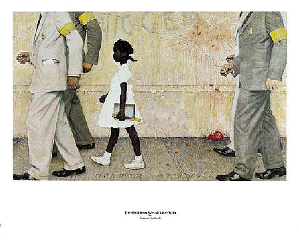
This portrait titled, The Problems We All Live With, was painted in 1964 by artist Norman Rockwell. This painting, although not seemingly significant by the first glance, gains much more importance with an increase in understanding of the particular cultural context in which it was written. Norman Rockwell did not simply paint this picture for aesthetic appeals, it was painted with purposeful visual argument to create an argument about the current situations about the time.
In 1954, the case Brown vs. Board of Education, the case 1896 Plessy vs. Ferguson which allowed for segregation of blacks and whites was overturned (http://brownvboard.org/summary/). Whites and blacks were no longer to be forced to attend separate schools. However, due to many racial feelings and tensions still present in the Southern United States, many schools and towns failed to enforce this court decision, and segregation was still a very real part of daily life for blacks in these times. This time is also characterized by the movements of famous African Americans like Martin Luther King Jr. who were influential in the civil rights movement. However, this painting deals more specifically with the story of Ruby Bridges.
Ruby Bridges was chosen by the http://www.naacp.org/ to be one of the first young black students to enter into the all white public schools as a way to enforce the rulings of Brown vs. Board of Eduacation (http://www.ci.troy.mi.us/law/LawDay2004/TheProblem.asp). It is this rare situation or moment that Norman Rockwell is able to capture and freeze in time in his visual rhetoric.
Through many means of visual cues, Rockwell depicts the scene of Ruby Bridges walking to school and manages to capture the feelings of emotion of the angry whites, as well as the awkwardeness of the situation. The splattered tomato, often thrown in the culture of this time by audience members who disapprove of the performance being acted out, is a subtle but effective reminder of the displeasure most of the whites found in this government action. The word "nigger" scrawled on the wall in graffiti style behind ruby, also culturally significant since it is a word very deragatory of African Americans, also contributes to develop and argue the feelings of tension in the audiencs. Even the white dress ruby is wearing contrasts with the color of her own skin, in some ways pointing out that that is the sole issue of the situation. The men in suits function as governemental aid that is necessary to "force" this action. Even the title of the painting, The Problems We All Live With, plays a significant role in the argument.
Interestingly, all these visual cues that are part of the text and significant through the cultural context can be interepreted in many ways by the audience. The "problems" to the audience could be the feelings of racism towards the black that the blacks have to deal with, or they can also be the feelings of being wronged or stolen from that many of the whites may have felt.
No comments:
Post a Comment